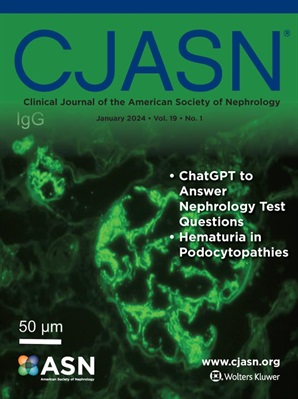Predicting Remission in Anti-PLA2R Antibody-Associated Membranous Nephropathy: A Secondary Analysis of the GEMRITUX, MENTOR and STARMEN Trials.
IF 8.5
1区 医学
Q1 UROLOGY & NEPHROLOGY
Clinical Journal of the American Society of Nephrology
Pub Date : 2025-04-14
DOI:10.2215/cjn.0000000694
引用次数: 0
Abstract
BACKGROUND In patients with anti-phospholipase A2 receptor (PLA2R) antibody associated membranous nephropathy, there is currently no accepted method to predict an individual's probability of remission after treatment with immunosuppression or supportive therapy using changes in antibody levels and clinical variables during the first 3-6 months of therapy. METHODS Using a cohort of 187 patients from the GEMRITUX, MENTOR and STARMEN clinical trials with antibody levels at baseline ≥14 RU/ml, we derived logistic regression models to predict proteinuria remission at 12 months that can be used at baseline or after three or six months of treatment. Treatment exposures in the trials included supportive therapy, rituximab, calcineurin inhibitors and cyclophosphamide. Predictors in the models included male sex, and baseline and changes in serum albumin, proteinuria, and antibody levels, with or without changes in eGFR. RESULTS Proteinuria remission at 12 months was achieved in 107 patients. Compared to the model at baseline, the three- and six-month models had better model fit with lower Akaike Information Criterion (186/158 vs 225) and higher R2 (52.7%/62.4% vs 25.8%), better discrimination with higher C-statistic (0.87 and 0.91 vs 0.75, P<0.001), and better calibration with lower integrated calibration index (0.89%/2.22% vs 2.51%). The three- and six-month models had no consistent difference in prediction performance and decision curve analysis demonstrated similar net benefit for treatment decisions based on either model up to a threshold probability of 31%. Prediction performance was similar after internal validation using optimism correction. Prediction performance was maintained within subgroups of different treatment regimens, including supportive therapy, rituximab, calcineurin inhibitors and cyclophosphamide. CONCLUSIONS Either the three- or six-month models can be used in patients with anti-PLA2R antibody associated membranous nephropathy after three or six months of treatment with a variety of immunosuppression or supportive therapy to predict remission status at 12 months.预测抗pla2r抗体相关膜性肾病缓解:对GEMRITUX、MENTOR和STARMEN试验的二次分析
背景在抗磷脂酶 A2 受体(PLA2R)抗体相关膜性肾病患者中,目前还没有一种公认的方法可以利用治疗头 3-6 个月中抗体水平和临床变量的变化来预测患者接受免疫抑制或支持疗法后病情缓解的概率。方法通过研究基线抗体水平≥14 RU/ml的GEMRITUX、MENTOR和STARMEN临床试验中的187例患者,我们得出了预测12个月后蛋白尿缓解的逻辑回归模型,该模型可在基线或治疗3个月或6个月后使用。试验中的治疗暴露包括支持疗法、利妥昔单抗、钙神经蛋白酶抑制剂和环磷酰胺。模型中的预测因素包括男性性别、血清白蛋白、蛋白尿和抗体水平的基线和变化,以及 eGFR 是否发生变化。与基线时的模型相比,3 个月和 6 个月的模型具有更好的模型拟合度(更低的 Akaike 信息标准(186/158 vs 225)和更高的 R2(52.7%/62.4% vs 25.8%))、更好的区分度(更高的 C 统计量(0.87 和 0.91 vs 0.75,P<0.001))和更好的校准度(更低的综合校准指数(0.89%/2.22% vs 2.51%))。三个月和六个月的模型在预测性能上没有一致的差异,决策曲线分析表明,在阈值概率为 31% 的情况下,根据任一模型做出治疗决策的净收益相似。在使用乐观校正进行内部验证后,预测效果相似。结论抗PLA2R抗体相关膜性肾病患者在接受各种免疫抑制或支持疗法治疗3个月或6个月后,可使用3个月或6个月模型预测12个月时的缓解状态。
本文章由计算机程序翻译,如有差异,请以英文原文为准。
求助全文
约1分钟内获得全文
求助全文
来源期刊
CiteScore
12.20
自引率
3.10%
发文量
514
审稿时长
3-6 weeks
期刊介绍:
The Clinical Journal of the American Society of Nephrology strives to establish itself as the foremost authority in communicating and influencing advances in clinical nephrology by (1) swiftly and effectively disseminating pivotal developments in clinical and translational research in nephrology, encompassing innovations in research methods and care delivery; (2) providing context for these advances in relation to future research directions and patient care; and (3) becoming a key voice on issues with potential implications for the clinical practice of nephrology, particularly within the United States. Original manuscript topics cover a range of areas, including Acid/Base and Electrolyte Disorders, Acute Kidney Injury and ICU Nephrology, Chronic Kidney Disease, Clinical Nephrology, Cystic Kidney Disease, Diabetes and the Kidney, Genetics, Geriatric and Palliative Nephrology, Glomerular and Tubulointerstitial Diseases, Hypertension, Maintenance Dialysis, Mineral Metabolism, Nephrolithiasis, and Transplantation.

 求助内容:
求助内容: 应助结果提醒方式:
应助结果提醒方式:


